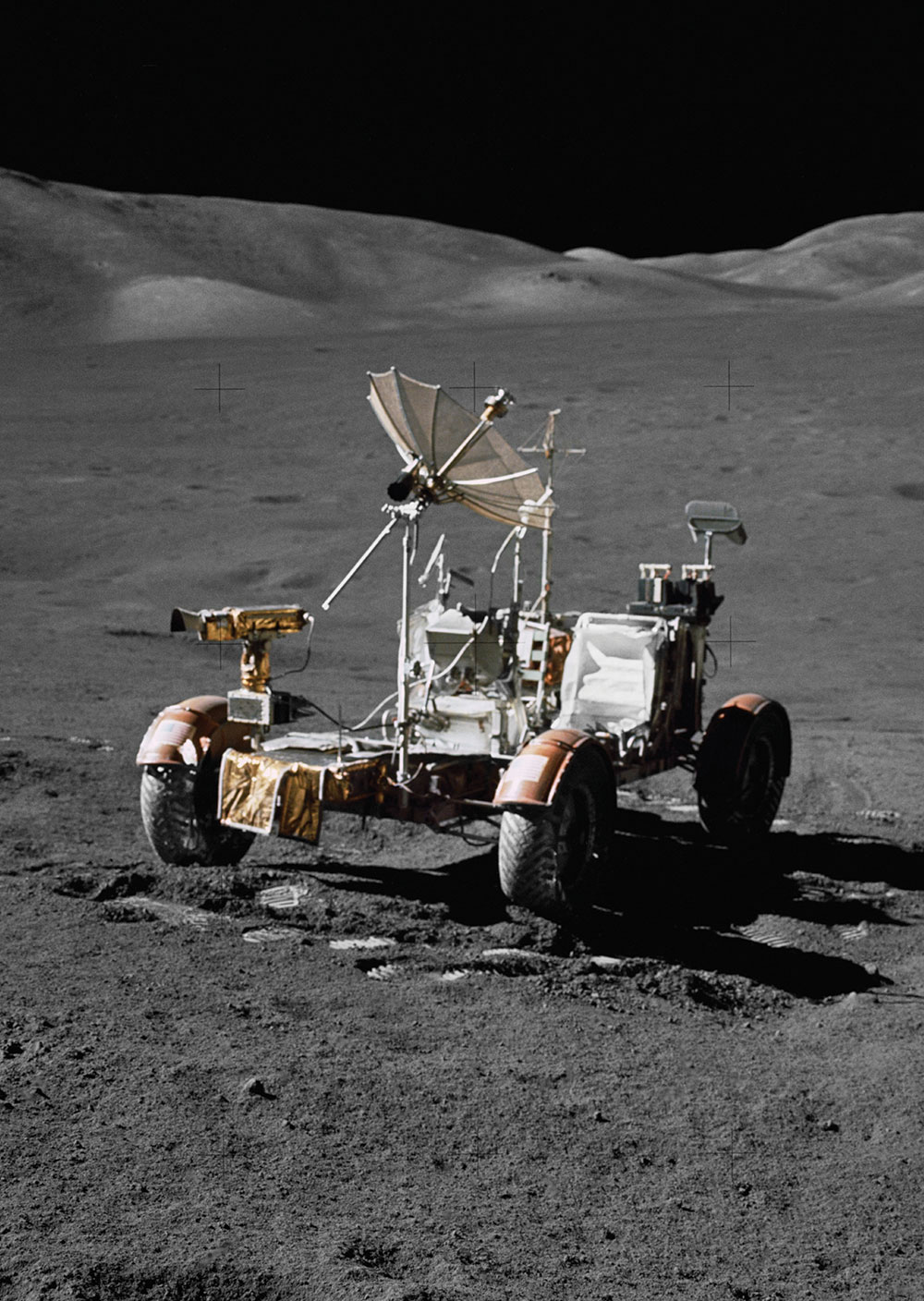Rocket Men
Photos Courtesy of NASA
“Oh, this is really profound. I’ll tell you, this is absolutely mind-boggling up here.” With those words, astronaut David Scott, 1949-50, HDAS’71, shared his awe as he ascended into space alongside James Irwin, MSE’57, HSCD’71, and Alfred Worden, MSE’63, HDAS’71, as part of the Apollo 15 crew — otherwise known as the all-UM astronaut crew.
It was the summer of 1971, just two short years after Apollo 11 captivated the nation with NASA’s first manned mission to land on the moon.
With Apollo 15, Scott, Irwin, and Worden would take their turn as the program’s ninth crewed mission and the fourth to land on the moon. Scott and Irwin would become the seventh and eighth humans to walk on the moon, while Worden remained behind to pilot the command module. All three would fulfill the mission’s objective of exploration and experiments over the course of several days.
On this, the 50th anniversary of the mission, Michigan Alumnus shares some Apollo 15 highlights.
We eagerly anticipate the challenge of the Hadley-Apennine with the accompaniment of the banner of the University of Michigan."
— Apollo 15 Commander David Scott, speaking before the mission
About 100 students, faculty, and staff — including President Robben Fleming — traveled to Florida to watch the launch. NASA authorized VIP viewing passes for the group in honor of the mission’s all-UM alumni crew.

MISSION OBJECTIVES
To explore the Hadley-Apennine region, set up and activate lunar surface scientific experiments, make engineering evaluations of new Apollo equipment, and conduct lunar orbital experiments and photographic tasks. The crew met all objectives.
CREW
Commander
David R. Scott, 1949-50, HDAS’71
Command module pilot
Alfred M. Worden, MSE’63, HDAS’71
Lunar module pilot
James B. Irwin, MSE’57, HSCD’71
SPACECRAFT
Command module: Endeavor
Lunar module: Falcon
Particle and Fields Subsatellite
MISSION DURATION
12 days, 7 hours, 12 minutes
July 26, 9:34 a.m. EDT
Apollo 15 launches from Cape
Canaveral, Florida.
July 30, 6:16 p.m. EDT
Scott and Irwin land the lunar module in the Hadley-Apennine region of the moon.
Aug. 2, 1:11 p.m EDT
The lunar module lifts off the moon for its rendezvous with the command module.
Aug. 7, 4:46 p.m. EDT
Apollo 15 splashes down in the Pacific Ocean, about 335 miles north of Honolulu.
SCIENTIFIC EXPERIMENTS
Number of instruments:
- 13 for lunar surface experiments
- 3 for the Particle and Fields Subsatellite
- 14 for orbital experiments
During three days on the lunar surface, Scott and Irwin:
- completed 18 hours, 37 minutes of exploration
- traveled 17.5 miles in the Lunar Roving Vehicle
- collected more than 170 pounds of lunar samples
- set up the Apollo Lunar Surface Experiments Package (ALSEP) array
- obtained a core sample from about 10 feet beneath the lunar surface
- provided extensive oral descriptions and photographic documentation of geologic features in the vicinity of the landing site
While alone in the command module, Worden operated the sensors in the SIM bay of the service module, collecting data on the moon and its environment.
The hammer-feather drop: To demonstrate Galileo’s theory that all objects in a given gravity field fall at the same rate, regardless of mass, in the absence of aerodynamic drag, Scott dropped a hammer and feather at the same time. The objects hit the ground at the same time.

THE FIRST ALL-UM CREW
Apollo 15 was not the first all-UM astronaut crew; that distinction goes to Gemini IV. On June 3, 1965, James A. McDivitt, ’59, and Edward H. White II, MS’59, lifted off on a mission to evaluate and test the effects on the crew of four days in space. White also accomplished the first U.S. spacewalk. That same month, they returned to a heroes’ welcome in Ann Arbor: a parade down Main Street and honorary U-M degrees.
Both continued their careers with NASA after the Gemini IV mission. McDivitt was head of the moonshot program at the time of Apollo 15. Tragically, White was one of three astronauts killed in the Apollo 1 spacecraft fire of 1967.

WORLD RECORD
As photographed from the lunar module, the Apollo 15 command
and service modules are in lunar orbit with the moon’s surface in the background. Worden piloted the command module while Scott and Irwin were on the moon’s surface. The three days he spent alone earned him a place in the “Guinness Book of World Records” as the “most isolated human being.”
All three astronauts received honorary U-M degrees at the Dec. 19, 1971, winter commencement.
MISSION MILESTONES
• First of the J missions.
These missions were able to explore over longer periods of time and greater ranges, and to gather more scientific data than previous missions.
• First to use the Lunar Roving Vehicle (LRV).
Traveling at speeds up to 6 to 8 mph, the LRV allowed the astronauts to travel far from the lander and still have enough time to perform their experiments.
• First spacewalk in deep space.
At approximately 171,000 nautical miles from Earth, Worden exited the Endeavor, climbed toward the rear of the service module, retrieved film cassettes from the scientific instrument module bay cameras, and returned to the Endeavor.
• First crewed spacecraft to place a satellite in lunar orbit.
The objectives of the small satellite were to investigate the moon’s mass and gravitational variations, particle composition of space near the moon, and the interaction of the moon’s magnetic field with that of Earth.
U-M CONNECTIONS
The crew carried three U-M mementoes with them to the moon:
• The charter of the U of M Alumni club of the Moon, pictured, which they left on the moon (The Alumni Association recognizes the club to this day.)
• A miniature of the U-M flag
• A miniature of the seal of the U- M department of aerospace engineering




